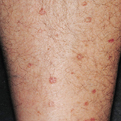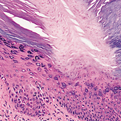Porokeratosis
General Information
Porokeratosis is a skin disease characterized by a thickening of the stratum corneum together with progressive centrifugal atrophy. Classic porokeratosis of Mibelli is one type of porokeratosis usually appearing in childhood, but lesions may be present at birth, puberty or later. Occasionally there is a family history of porokeratosis, suggesting a genetic predisposition. The lesions develop as small, tan, scaly papules that expand to irregularly shaped plaques. A warty rim separates each plaque. The lesions are mainly seen on the limbs, although any part of the body may be affected. Disseminated superficial actinic porokeratosis (DSAP) is a relatively common type of porokeratosis. DSAP is a skin condition causing multiple red to brown dry patches mainly on the arms and legs. It expands and a sharp, slightly raised, ring develops around the lesion. DSAP is inherited as an autosomal dominant characteristic; meaning on average half of children that have parents with the condition will also have the tendency. New lesions of DSAP can be provoked by ultraviolet radiation. Treatment is for appearance of the lesions, as there is no cure for the disease. The medication includes topical imiquimod 5% cream, Calcipotriol cream, Oral acitretin or isotretinoin, Cryotherapy, Dermabrasion or Carbon dioxide laser ablation. Sun protection is very important as exposure to ultraviolet radiation may result in the development of skin cancer within the porokeratosis lesion.
Epidemiology
Disseminated superficial actinic porokeratosis (DSAP) is relatively common in the United States, other forms are rare.
Etiology
Classic porokeratosis (Mibelli) – Genetic and Immunosuppression. Disseminated superficial (actinic) porokeratosis – Ultraviolet radiation exposure in genetically predisposed patients, Immunosuppression
Pathogenesis
Clinical
Classic porokeratosis (Mibelli) – Small, light brown, keratotic papules that expand to form an irregularly shaped, annular plaque with a raised, ridge like border. Disseminated superficial (actinic) porokeratosis – Small, indistinct, light brown patches with a threadlike borders
Histology
Cornoid lamella is the hallmark seen in all porokeratosis forms consisting of a thin column of tightly packed parakeratotic cells within a keratin-filled epidermal invagination
Bibliography
1. “Porokeratosis of Mibelli” (Online). March 2008. http://dermnetnz.org/scaly/porokeratosis-mibelli.html (visited: April 2, 2008) 2. “Disseminated superficial actinic porokeratosis” (Online). March 2008. http://dermnetnz.org/scaly/dsap.html (visited: April 2, 2008) 3. “Porokeratosis” (Online). March 2007. http://www.emedicine.com/derm/topic343.htm (visited: April 2, 2008)
Download PDF
![]() Porokeratosis
Porokeratosis


